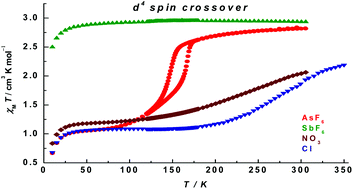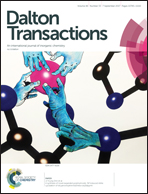The molecular and supramolecular aspects in mononuclear manganese(iii) Schiff-base spin crossover complexes†
Abstract
Manganese(III) hexadentate Schiff base complexes ([Mn(sal-N-1,5,8,12)]Y·S, Y = AsF6 (1); Y = SbF6 (2); Y = NO3, S = C2H5OH (3) and Y = Cl (4)) have been investigated to determine the impact of anion effects, intramolecular ligand distortions, and intermolecular supramolecular structures on the spin crossover (SCO) behavior. The crystal structure of [Mn(sal-N-1,5,8,12)]PF6, a complex known to exhibit an abrupt SCO behavior with an 8 K hysteresis window, reveals that this complex has a temperature-dependent anion order–disorder transition that disrupts the hydrogen-bonding chain upon SCO, indicating that hydrogen bonds between cations and anions greatly influence the magnetic properties. The SCO in 1 is mediated by intermolecular hydrogen-bonding interactions. The subtle balance of these hydrogen bonds induces a cooperative SCO process with a hysteresis width of 18 K, which is the largest one reported in the d4 SCO chemistry. For 2, crystal structural analysis indicates that changing the anion from AsF6− to SbF6− led to close stackings between phenyl groups from ligands. These stackings preclude the spin transition of the [Mn(sal-N-1,5,8,12)]+ cations. With NO3− and Cl− as counterions, the [Mn(sal-N-1,5,8,12)]+ cations are arranged more loosely and exhibit gradual SCO in the temperature range of 300–100 K. Careful evaluation of the supramolecular structures of these complexes and similar complexes reported previously revealed strong correlation between the supramolecular packing forces and their magnetic properties.



 Please wait while we load your content...
Please wait while we load your content...